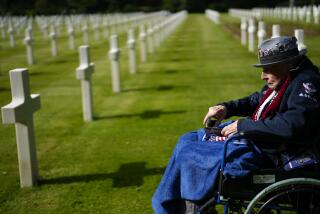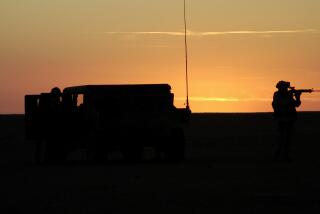Infamous Death March and Fall of Bataan Still Echo Across the Years
- Share via
Those of you of my generation may remember, when reminded--and others may recall from the quick dust-off given American history in schools these days--that during this week 48 years ago, the American soldiers defending the Philippine Islands were pushed back to a place called the Bataan Peninsula where they were decimated and the remnants captured by the Japanese. The final American bastion was a fortress called Corregidor, two miles off Bataan. The main American force surrendered on April 9, and the final holdouts on Corregidor almost a month later.
In between took place an event that became a rallying cry for all Americans during the rest of World War II: the Bataan Death March.
More than 60,000 Filipino and 12,000 American soldiers were taken prisoner by the Japanese on Bataan. Hurt, hungry and exhausted, they were forced to march to a prison camp 55 miles away. As a direct result of the contempt and brutality of their Japanese captors along the way, almost 10,000 of these prisoners died during that forced march.
Gen. Douglas MacArthur was rescued to fight another day--that’s when he made his famous pledge, “I shall return”--but there was no rescue possible for the troops he led. In the spring of 1942, the United States was in no condition to send reinforcements to Bataan. We could only watch helplessly as our troops were killed or captured.
This history has a special meaning for me, and I play the same drama over in my head every year when I read the inevitable anniversary stories. The details are graven into my memory because in the summer of 1945 I flew the first group of released Death March prisoners back to the United States.
MacArthur, of course, did return as he had promised, wading ashore on the Philippine island of Leyte on Oct. 20, 1944--several times, as a matter of fact, so press cameras could record the moment properly--at the head of a U.S. invasion force.
It took three months of hard fighting before the Americans pushed the Japanese into northern Luzon--and in the process overran the prison camp in which the Bataan Death March survivors had been held. Our liberated prisoners spent several months in hospitals and rest camps before we started flying them home, triumphant symbols that the books were finally being balanced in the Philippines.
At that time, I was a pilot assigned to the Naval Air Transport Service in the South Pacific, and when I reported to my squadron on the morning of June 27, 1945, to fly a trip from John Rogers Field in Hawaii to NAS Oakland, I found I had a very special planeload of passengers. My crew would be carrying the first load of Bataan Death March survivors to the United States.
We were busy in the cockpit and couldn’t watch them come aboard. But I remember flashes of gaunt, emaciated men, and I was acutely aware of silence as they filed onto the plane. There was none of the exuberance we had seen so often of GIs going home. Just an eerie, almost opaque silence.
Back in those primitive days, it took our DC-4 almost nine hours to make the trip from Oahu to Oakland, and all my latent journalistic juices began flowing as soon as we pulled up the landing gear. As soon as I decently could, I left the controls to my co-pilot and walked back into the cabin. I wanted to hear, firsthand, what these men had experienced over the past three years. I wanted a graphic description of the Death March. I wanted to know what they were feeling now on their way home.
The cabin was silent as I wandered through it, looking into faces, trying to make eye contact so I could hunker down in the aisle and talk. None of the men looked at me. Most of them looked straight ahead or stared out the window at the expanse of sky and sea. I finally found an empty seat, sat down and tried to start a conversation with the man next to me.
What happened was repeated several times before I finally returned to the flight deck. The men were polite, soft spoken and monosyllabic. Sometimes they looked at me blankly when I asked anything but the simplest question. They clearly had no interest in talking--at least with me--about what had happened to them. And I tried enough of them to convince me that this lack of response was probably not going to change.
Back in the cockpit, I thought about this.
Had their experiences been so traumatizing that they simply rejected the pain of bringing them up again? Or were they so overwhelmed at actually being only a few hours from home that they didn’t want anything to interfere with those feelings? Or were they unwilling--or perhaps unable--to share their experiences with a stranger who had no common ground for understanding what they had been through?
I still don’t know.
We found a rare clear day when we reached San Francisco, and we had a little fuel left. So we brought our passengers forward into the cockpit a half-dozen at a time and flew over and around the city so they could drink it in. They seemed appreciative, and they looked hungrily out the windows. But there was no shouting, no exhilaration, no letting go.
Almost five decades later, I can still recall those faces as vividly as when I walked down the aisle of that airplane. These men were on their way home, where they would be seen as heroes, larger-than-life survivors of America’s last holy war. But perhaps they had seen too much of man’s brutality to permit them to let the good times back in. I’ve wondered many times since when--if ever--they did.
More to Read
Sign up for Essential California
The most important California stories and recommendations in your inbox every morning.
You may occasionally receive promotional content from the Los Angeles Times.













